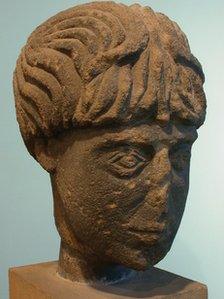Head of 'Geordie Roman god' found at Binchester
- Published

Experts think the head may be that of Antenociticus
A 1,800-year-old carved stone head of a possible Roman god has been found in an ancient rubbish dump in County Durham.
The discovery was made at Binchester Roman Fort, near Bishop Auckland, as a team dug through an old bath house.
The 20cm sandstone head, from the 2nd or 3rd century, is similar to Celtic deity Antenociticus, thought to have been worshipped locally in war time.
A similar head with an inscription identifying it as Antenociticus, was found in Newcastle, in 1862.
The find, by first year archaeology student, Alex Kirton from Hertfordshire, was made as part of a five-year project at Binchester Roman Fort, which is attempting to shed new light on the twilight years of the Roman Empire.
Small shrine
Dr David Petts, lecturer in Archaeology at Durham University, said: "We found the Binchester head close to where a small Roman altar was found two years ago.
"We think it may have been associated with a small shrine in the bath house and dumped after the building fell out of use, probably in the 4th century AD.
"It is probably the head of a Roman god - we can't be sure of his name, but it does have similarities to the head of Antenociticus found at Benwell in the 19th century.
"Antenociticus is one of a number of gods known only from the northern frontier, a region which seems to have had a number of its own deities.
"It's possibly a Geordie god, though it could have been worshipped at the other end of the wall."
Antenociticus is not mentioned at any other Romano-British site or on any inscriptions from Europe, which is why it has been identified as a local deity.
The dig is a joint project between Durham University's Department of Archaeology, site owner Durham County Council, Stanford University's Archaeology Centre and the Architectural and Archaeological Society of Durham and Northumberland.
- Published9 September 2011
- Published21 April 2011
- Published17 June 2011
- Published16 September 2010
- Published2 April 2011